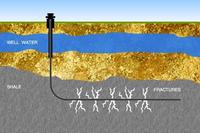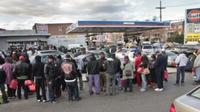-
Many NYC buildings to remain closed for weeks, months for clean-up, repairs
Water and winds produced by Hurricane Sandy destroyed mechanical and electrical systems in many commercial and residential buildings in Lower Manhattan; as a result, many buildings in the area are weeks or months away from being repaired and fully operational
-
-
Protecting New York City from storms, surges
Almost a week after Hurricane Sandy hit New York City; people are still picking up the pieces of their former lives; for New York officials, the next step is decide how best to protect New York City from a similar disaster in the future; there are many ideas and proposals, ranging from moveable sea gates, to expanding protective marshlands and wetlands, to creating a system of artificial reefs in the channel along the Red Hook and Gowanus neighborhoods of Brooklyn, made out of rocks, shells, and fuzzy rope that will promote the growth of oysters
-
-
Nuclear energy facilities proved themselves resilience during Hurricane Sandy

There are thirty-four nuclear energy facilities in the area hit by Hurricane Sandy; all of them have responded well and safely to the powerful storm; the industry says that careful planning and preparations days in advance of the storm paid off at all of these facilities
-
-
Hurricane Sandy offered support for reliance on nuclear power
A Scientific American writer is impressed with the way nuclear power facilities were able safely to withstand the wrath of Hurricane Sandy; the lesson he draws from this experience: “Global warming is increasing the probability and destructiveness of extreme weather events like Sandy. (I don’t see the point of dithering over this claim any more.) The last thing we should do in the face of this threat is abandon nuclear energy. If anything, we need more nuclear power, not less, to curb global warming”
-
-
Fracking: fact vs. fiction

In communities across the United States, people are hearing more and more about a controversial oil and gas extraction technique called hydraulic fracturing — aka, hydro-fracking; controversies pivot on some basic questions: Can hydro-fracking contaminate domestic wells? Does it cause earthquakes? How can we know? What can be done about these things if they are true? Experts making presentations at the Geological Society of America (GSA) meeting this week in Charlotte, North Carolina, will address these and related critical questions
-
-
Gasoline shortages, housing problems, power slowly returning

Anger is growing over gasoline shortages in New York and New Jersey; gas rationing was imposed in northern New Jersey; crowds lined up at free fuel distribution sites in New York City’s five boroughs, with a limit of ten gallons per person; more New Yorkers got power Saturday for the first time since Sandy struck; power has been restored to about 60 percent of the New York metropolitan area, with about 900,000 still without electricity, including about 550,000 on Long Island; about 2.6 million people remained without power in six states after Sandy came ashore Monday night; in New York, 30,000 to 40,000 people, mainly residents of public housing, will have to find new homes, Mayor Michael Bloomberg said Sunday
-
-
USGS sampling water in Hurricane Sandy’s aftermath to ensure public health
Excessive nutrients in U.S. rivers, streams, and coastal areas are a major issue for water managers, because they cause algal blooms that increase costs to treat drinking water, limit recreational activities, and threaten valuable commercial and recreational fisheries; U.S. Geological Survey crews are sampling water for nutrients, sediment, and pesticides to document water quality in areas affected by the hurricane
-
-
The science of hurricanes is imprecise, but delayed decisions on preparedness and adaptation may cost lives

It is difficult to tie a specific storm like Hurricane Sandy to the phenomenon of climate change; a professor of civil and environmental engineering says that this is a perfect example where the climate science may not yet be as precise as we would like, but important preparedness decisions still need to be made with some urgency; this is also an example where delayed decisions on preparedness and adaptation may cost human lives, destroy critical infrastructures, and damage economies; the importance of adaptation and preparedness in this context cannot be overstated
-
-
California worried about its own extreme weather
California will not see a superstorm like Hurricane Sandy because the Pacific Ocean is too cold to feed that kind of weather system, but researchers monitoring precipitation and snowpack say weather can have comparable effects
-
-
Sandy in perspective
Hurricane Sandy has left death and destruction in its path, and it broke a few records, but there were worse hurricanes; since 1900, 242 hurricanes have hit the United States; if Sandy causes $20 billion in damage, in 2012 dollars, it would rank as the seventeenth most damaging hurricane or tropical storm out of these 242; the Great Miami Hurricane of 1926 tops the list; Hurricane Katrina ranks fourth; from August 1954 through August 1955, the East Coast saw three different storms make landfall — Carol, Hazel, and Diane; each, in 2012, would have caused about twice as much damage as Sandy
-
-
Sea levels are rising ahead of predictions; scientists explain why
The last official Intergovernmental Panel on Climate Change (IPCC) report in 2007 projected a global sea level rise between 0.2 and 0.5 meters by the year 2100; current sea-level rise measurements meet or exceed the high end of that range and suggest a rise of one meter or more by the end of the century; scientists meeting next week at the Geological Society of America annual meeting will discuss whether estimates of the rate of future sea-level rise are too low
-
-
Flying robot avoids obstacles
Researchers have created an autonomous flying robot which is as smart as a bird when it comes to maneuvering around obstacles; able to guide itself through forests, tunnels, or damaged buildings, the machine could have tremendous value in search-and-rescue operations
-
-
Rising sea levels make NYC vulnerable to more frequent, more intense floods
Scientists say that Hurricane Sandy has forced a recognition on New York City and on other coastal communities: the steady rise in sea levels means not only more floods, but more frequent and more devastating floods; three of the top 10 highest floods at the Battery since 1900 happened in the last two and a half years; after rising roughly an inch per decade in the last century, coastal waters in New York are expected to climb as fast as six inches per decade, or two feet by midcentury; the city is exploring a $10 billion system of surge barriers and huge sea gates
-
-
Why some quakes lead to faster shaking
The more time it takes for an earthquake fault to heal, the faster the shake it will produce when it finally ruptures, according to a new study; the research does nothing to bring scientists closer to predicting when the next big one will hit, but the findings could help engineers better assess the vulnerabilities of buildings, bridges, and other structures when a fault does rupture
-
-
Study connects burning fossil fuels to sea level rise
A study has found that burning all the Earth’s reserves of fossil fuels could cause sea levels to rise by as much as five meters — with levels continuing to rise for typically 500 years after carbon dioxide emissions ceased
-
More headlines
The long view
Using Drone Swarms to Fight Forest Fires
Forest fires are becoming increasingly catastrophic across the world, accelerated by climate change. Researchers are using multiple swarms of drones to tackle natural disasters like forest fires.
How Climate Change Will Affect Conflict and U.S. Military Operations
“People talk about climate change as a threat multiplier,” said Karen Sudkamp, an associate director of the Infrastructure, Immigration, and Security Operations Program within the RAND Homeland Security Research Division. “But at what point do we need to start talking about the threat multiplier actually becoming a significant threat all its own?”
